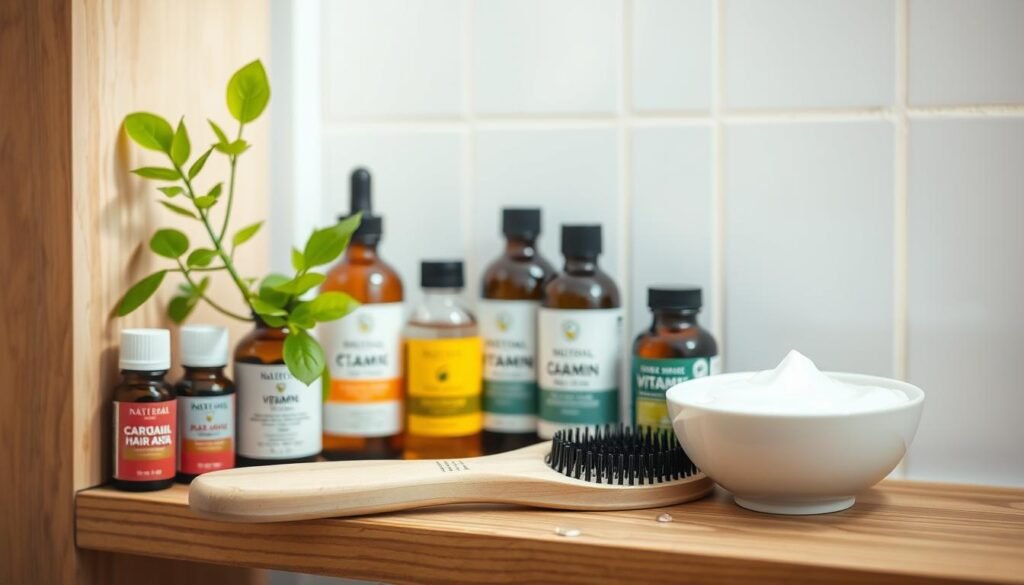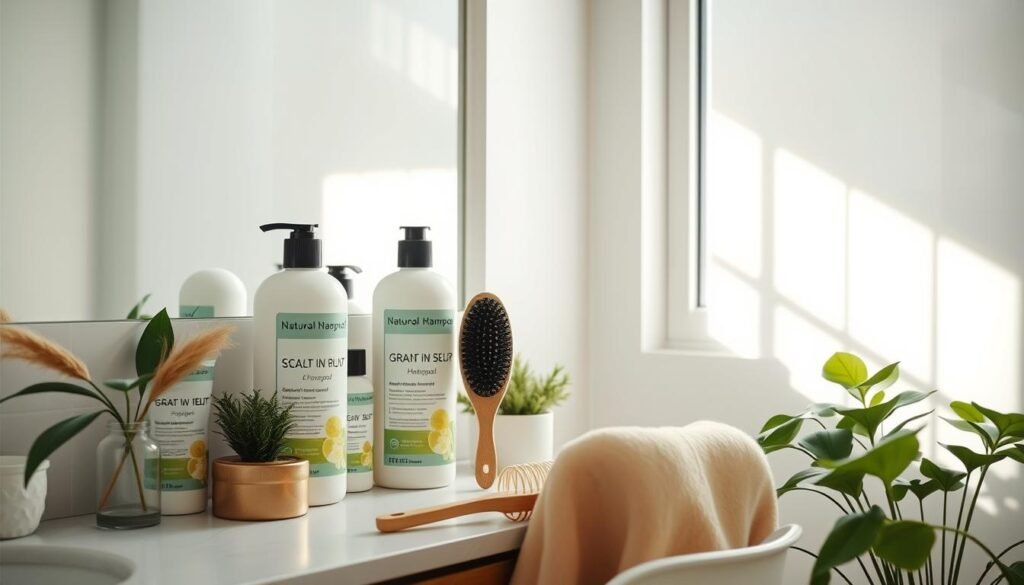About 1 in 50 people will face alopecia areata in their lifetime. This issue often links back to Prednisone use. Many are searching for ways to tackle this unwanted side effect. We’re here to offer expert advice on stopping hair loss after prednisone. Our focus is on prevention, boosting hair regrowth, and keeping hair healthy. Learn more about managing hair loss while on steroids.
Key Takeaways
- Prednisone use can lead to hair loss, impacting some individuals more than others.
- Understanding the side effects and mechanisms of Prednisone is crucial for management.
- Consulting a healthcare professional is vital for personalized hair loss strategies.
- Maintaining a healthy lifestyle can aid in preventing hair loss from prednisone.
- Effective treatments like minoxidil and finasteride may support hair regrowth after prednisone use.
Understanding Prednisone and Its Uses
What is prednisone? It’s a type of medication called corticosteroids. It’s used for many health issues. These issues range from asthma and allergies to arthritis and autoimmune diseases. It works like cortisol, a natural hormone, to control inflammation and the immune system’s response.
This medication is key in treating autoimmune problems like lupus and multiple sclerosis. It helps manage symptoms during flare-ups. Yet, it’s important to know the side effects of using it for a long time.
Prednisone comes as tablets or liquid. Doctors adjust the dose to make sure it works well. This medication can reduce symptoms of many diseases. But it might not cure them. This means patients need ongoing treatment.
Here’s a quick overview of corticosteroid uses:
| Condition | Typical Use of Prednisone |
|---|---|
| Asthma | Reduces inflammation in the airways |
| Arthritis | Palliates joint pain and swelling |
| Allergies | Relieves severe allergic reactions |
| Autoimmune Diseases | Controls immune system overactivity |
Common Side Effects of Prednisone
People who take prednisone often feel different effects. These effects can change how they live day to day. They might get hungrier than usual and gain weight. It’s different for everyone, but some might gain more than 22 pounds in a year.
Another effect is bruising easily, and this is more likely if you’re on a high dose. Even small bumps can cause big bruises. Too much hair growth on the body, also known as hirsutism, can happen too.
Acne, especially on the face, can also occur after taking prednisone for a few weeks. Mood changes, like feeling irritable or anxious, are common. A study found that almost half of the people with a certain disease felt moody after two weeks on prednisone.
Taking prednisone for a long time can lead to other problems. For instance, you might get cataracts. It can also make it hard to sleep, causing insomnia and more anxiety. These effects can get better if the dose is changed or the medication is stopped. Knowing about these side effects can help you manage your health while on prednisone.
Does Prednisone Cause Hair Loss?
Many people wonder if taking prednisone leads to hair loss. Although it’s rare, some may find their hair thinning while on this medication. This situation can worry those already facing hair loss issues.
About 1-3% of people in the U.S. have tried anabolic steroids, often causing hair loss in men. A study found that 47% of alopecia areata patients saw 25% hair regrowth after using prednisone with 2% Minoxidil. These results show that recovery is possible with the right treatment.
Women might see a different effect, as steroids can increase body hair but thin out scalp hair. Sometimes, this hair loss becomes permanent. If you notice hair loss while on prednisone, it’s crucial to talk to a doctor to figure out why and what to do next.
It’s important to grasp how prednisone and hair loss are connected to get proper medical advice. Since everyone’s body responds differently, being closely watched by a doctor can help manage treatment and maintain hair health.
The Mechanism Behind Prednisone-Induced Hair Loss
Prednisone impacts our body and hair health by changing hormone levels. It increases DHT levels, known for harming hair follicles. This results in thinner hair and hair loss.
Using prednisone for a long time, especially in large doses, can lead to hair loss. For people prone to androgenetic alopecia, this risk is even higher. Prednisone makes hair follicles more sensitive to hormone shifts.
While prednisone might cause hair thinning, it can also help hair grow back in some cases. This is true for conditions like alopecia areata. How much hair you might lose depends on how long you take prednisone and your dosage. Lowering the dose slowly can help lessen hair loss and help your hair recover.
Making changes in your lifestyle is key to better hair health after prednisone. Eating well and managing stress helps your hair grow stronger. Knowing how to deal with prednisone’s side effects is very helpful.
How to Stop Hair Loss After Prednisone
Addressing hair loss after Prednisone means being thoughtful and informed. It’s vital to use practical strategies. Seeing a doctor is crucial, as only they can offer advice that fits you. Working with your doctor ensures the best path to getting your hair back.
Consulting Your Doctor for Personalized Advice
Before changing your hair care or meds, talk to a doctor. They can pinpoint why you’re losing hair and suggest how to fix it. This step is key in finding the right way to tackle hair loss post-Prednisone. Improving overall health, like balancing hormones and eating right, might also help your hair grow back.
Adjusting Dosage with Medical Guidance
Talking to your doctor about prednisone dosage is another important step. Changing the dose might reduce hair loss, but only do this with your doctor’s okay. For those ending high doses, reducing slowly lets your body adjust. This approach lessens problems and aids recovery, helping your hair too.
Preventing Hair Loss from Prednisone
To prevent hair loss from prednisone, a well-rounded approach is key. Choosing the right diet and lifestyle is crucial for hair health during treatment. It’s important to eat a balanced diet filled with vitamins and minerals. Foods like nuts, seeds, leafy greens, and lean proteins are great.
Drinking plenty of water supports healthy hair, since it helps move nutrients around. Good scalp care is also vital. Washing your hair with soft shampoos can prevent damage. Choose sulfate-free shampoos to keep your scalp moist.
To combat hair loss, reducing stress is effective. Yoga and meditation can help lower stress, which may decrease hair fall on prednisone. Talking with a doctor about hair concerns is advised for personalized advice. They can guide you on how to take care of your hair during treatment. Expert recommendations are helpful in this matter.
Using the right hair care products also plays a role. These products can nourish and strengthen hair. Following these tips can greatly help those wanting to reduce hair loss while on prednisone therapy.

Effective Hair Regrowth Treatments Post-Prednisone
After losing hair due to Prednisone, people look for good treatments to get their hair back. There are different methods that help with this. They focus on making your hair healthy and grow again.
Minoxidil for Regenerating Hair Growth
Minoxidil or Rogaine is a skin solution for hair loss. Research shows it really helps hair grow back after losing it from Prednisone, usually in 3-6 months. It makes hair follicles stronger and increases blood flow to your head, helping hair grow.
Finasteride: A Potential Solution
Finasteride is another choice for people with thinning hair. It mainly lowers DHT levels, which reduces hair loss from androgenetic alopecia. For those who lost hair because of Prednisone, it’s a great option. It could help bring back hair density over time.
Bio-Pilixin Serum: A Natural Approach
Bio-Pilixin Serum uses natural stuff to help make your scalp healthy and grow hair again after using Prednisone. It has plant ingredients that feed hair roots and help hair come back. This product is perfect for those preferring natural hair care solutions.
Managing Hair Loss Post-Prednisone
After stopping Prednisone, those experiencing hair loss should focus on a well-rounded hair care routine. It’s essential to look after your scalp both on the outside and from within. Good hygiene is key.
Choosing the right hair care products is vital. They should keep the scalp clean without causing buildup. This supports healthier hair.
Maintaining Scalp Hygiene and Health
For healthier hair, start with gentle shampoos and conditioners. These products should clean without removing important natural oils. Keeping the scalp clean helps in preventing issues like dandruff, which can further hair loss.
Light oils can also be beneficial. They support a healthy scalp environment, which encourages better hair growth.
Incorporating Nutrient-Rich Foods
Adding foods rich in nutrients is vital for managing hair loss after Prednisone. Biotin, Vitamin E, and minerals like zinc are key for hair growth. Eat plenty of leafy greens, nuts, seeds, and lean proteins to improve hair health.
A well-balanced diet helps in regrowing hair and boosts overall health. For more dietary tips for healthy hair, click here.

Preventing Hair Thinning from Prednisone
Working to stop hair thinning when using meds like prednisone needs a direct approach. Helpful strategies can truly make a vast difference. It’s key to start early to fight off steroid effects on hair.
Talking to a doctor about adjusting medication dosage is wise. This can cut down on the bad side effects, like losing hair. Keeping in touch with a doctor is vital, especially for ongoing treatments.
Eating foods full of vitamins helps both hair and scalp. Missing out on important nutrients might make hair thin more. A simple blood test by a doctor can show what you lack, leading to a fix.
Avoid stress to prevent hair thinning from prednisone. Stress hits hard, making more hair fall out than usual. Finding ways to relax and having support helps keep hair thick.
Looking into treatments like minoxidil might help those with thinning hair. It could encourage hair to grow back faster. Knowing these tips lets people deal with hair issues better while on prednisone. For more, click here.
| Strategy | Benefit |
|---|---|
| Consult Your Physician | Adjust medication for minimized hair loss |
| Balanced Diet | Support scalp health with vitamins and minerals |
| Stress Reduction | Lower the potential for telogen effluvium |
| Topical Treatments | Encourage hair regrowth effectively |
Prednisone and Hair Loss Remedies
Hair loss from prednisone use needs special treatments. Various strategies can improve hair health. One effective way is using DHT-blocking shampoos. These shampoos fight hair loss by blocking DHT, a hormone that causes hair to thin. They have natural ingredients that are good for the scalp and help with hair growth.
Topical DHT-Blocking Shampoos
Adding DHT-blocking shampoos to your daily hair care can help with prednisone-related hair loss. Ingredients like saw palmetto and pumpkin seed oil are in these shampoos. They fight against 5-alpha reductase, an enzyme that leads to hair loss. With regular use, these shampoos can make hair thicker and healthier.
Scalp Micropigmentation for Cosmetic Coverage
Scalp micropigmentation offers a quick fix for thin hair. It uses special pigments on the scalp to mimic fuller hair. It’s great for bald spots or receding hairlines. This method boosts confidence while you’re trying other hair loss treatments. For more on hair loss treatments, visit different options.

Combining various approaches works best for hair loss. Using topical minoxidil and taking nutritional supplements supports hair growth. Always talk to a doctor for advice on hair loss from medications. Making lifestyle changes and following effective treatments can help hair grow back.
Conclusion
Reversing prednisone-induced hair loss needs a detailed plan. Experts recommend seeing professionals for advice and changes to meds. Getting personalized care helps a lot in treating hair loss, helping hair grow back and boosting confidence.
Minoxidil and intralesional steroids are key for hair to regrow. Studies show intralesional steroids help a lot of people with alopecia areata. Along with these treatments, keeping the scalp healthy and eating well helps hair come back stronger.
There’s hope for those losing hair because of prednisone. Going to a dermatologist, watching your scalp’s health, and good hair care boost recovery chances. Learning more and getting support are important for dealing with the tough parts of hair loss.